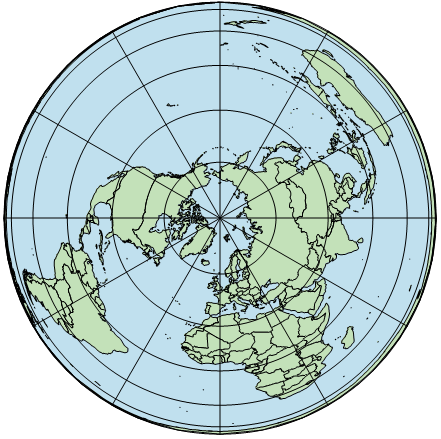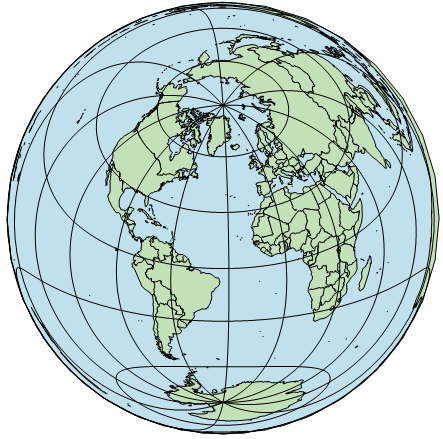AzimuthalEqualAreaProjection Class
The Lambert azimuthal equal-area map projection.
NuGet/Assembly: Carmenta.Engine.5.17.0.nupkg (in the CECore assembly)
Syntax
public class AzimuthalEqualAreaProjection : ProjectionRemarks
This is the Lambert azimuthal equal-area map projection, often abbreviated as LAEA (which should not be confused with Lambert conic equal-area, which is a special case of Albers conic equal-area.) Two sample maps in azimuthal equal-area projections are shown below.
 |
 |
The projection is azimuthal, but it is conformal only at the projection center.
The projection is continuous everywhere except at the antipode of the projection center. The antipode is projected to a boundary circle. Although the whole world can be shown, the region within 5000 km (45 degrees) from the antipode is quite distorted.
The projection is equal-area; that is, the areas of projected polygons are proportional to the true areas on earth. However, this requires the polygon edges to be short enough, so that each edge is straight enough both on the earth and on the map. The polygon should preferably be inside the hemisphere that is centered on the projection center, since polygon edges near the antipode are more distorted (bent).
You can choose the Earth shape you want (sphere or ellipsoid) via the Shape argument.
Inheritance Hierarchy
System.Object
EngineObject
ResourceObject
Projection
AzimuthalEqualAreaProjection
Platforms
Windows, Linux, Android
AzimuthalEqualAreaProjection Members
The AzimuthalEqualAreaProjection type has the following members.
Constructors
| Name | Description |
|---|---|
| AzimuthalEqualAreaProjection | Initializes a new instance of the AzimuthalEqualAreaProjection class. |
Properties
| Name | Description |
|---|---|
| Authority | Gets the name of an authority, which is often "epsg". Inherited from Projection |
| AuthorityCode | Gets the unique code for the projection instance, according to the Authority, for example "19883". Inherited from Projection |
| CentralLatitude | Gets the central latitude, also known as latitude of origin. |
| CentralLongitude | Gets the central longitude, also known as central meridian or longitude of origin. |
| FalseEasting | Gets the offset added to the projected x coordinates (the eastings). |
| FalseNorthing | Gets the offset added to the projected y coordinates (the northings). |
| IsDisposed | Gets a value that tells whether the current AzimuthalEqualAreaProjection has been disposed. Inherited from EngineObject |
| LengthUnit | Gets the length unit of the projected coordinates. |
| Gets a pre-defined LongLatProjection instance. Inherited from Projection | |
| Name | Gets or sets the name of the AzimuthalEqualAreaProjection. Inherited from ResourceObject |
| NativeHandle | Gets the native Carmenta Engine kernel object the current AzimuthalEqualAreaProjection represents. Inherited from EngineObject |
| Purpose | Gets a value that tells whether the projection instance is intended for data storage or for presentation. |
| Shape | Gets a value that tells whether the Earth is represented as a sphere or as an ellipsoid. |
| SphereRadius | Gets an explicitly specified sphere radius. |
| SphereRadiusSource | Gets a value that tells how the sphere radius is determined. |
| IUserProperties.UserProperties | Gets the AttributeSet that contains the user properties. Inherited from IUserProperties |
Methods
| Name | Description |
|---|---|
| Clone | Creates a copy of an object. Inherited from EngineObject |
| Dispose | Releases the reference to the native Carmenta Engine kernel instance the EngineObject represents. Inherited from EngineObject |
| Equals | Determines whether this instance is equal to another. Inherited from EngineObject |
| Returns one of the 120 predefined instances of Universal Transverse Mercator. Inherited from Projection |